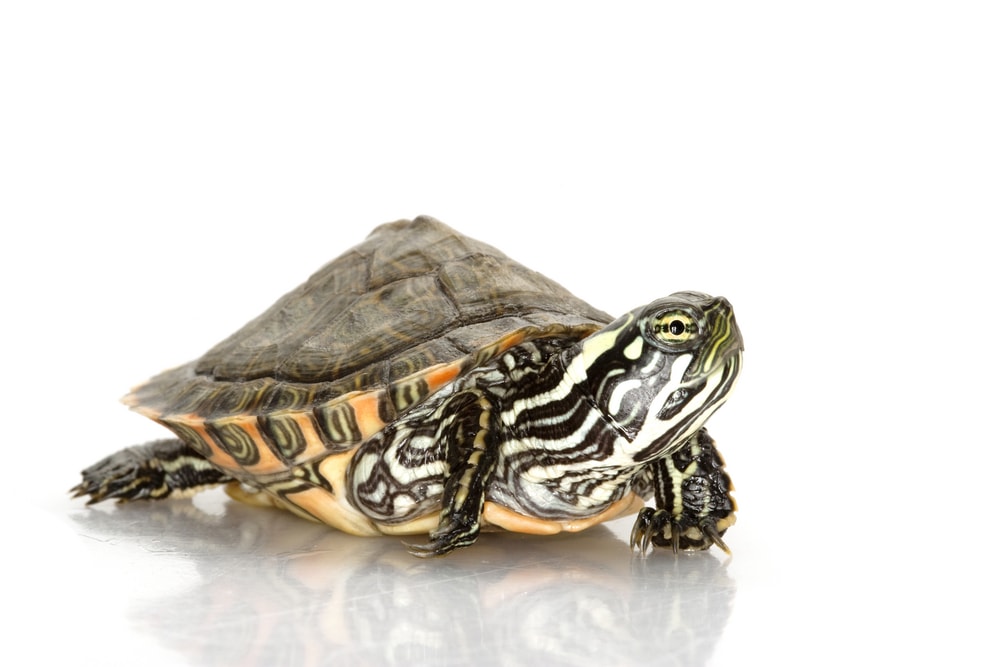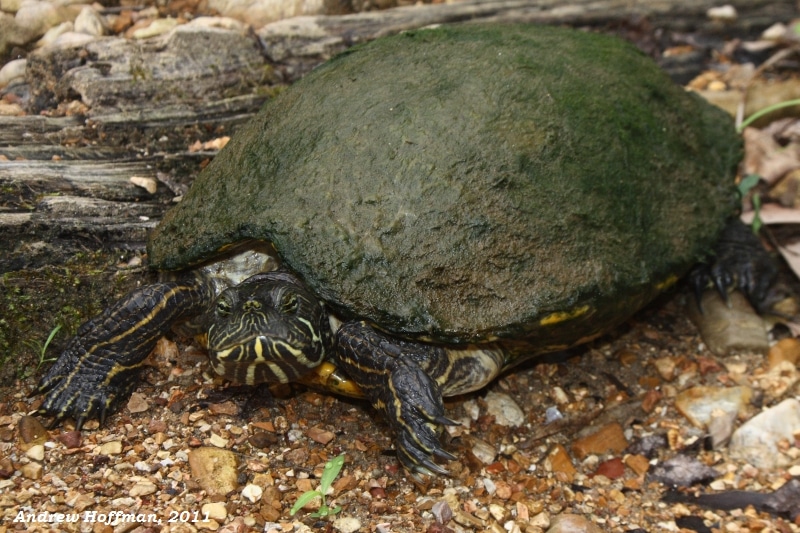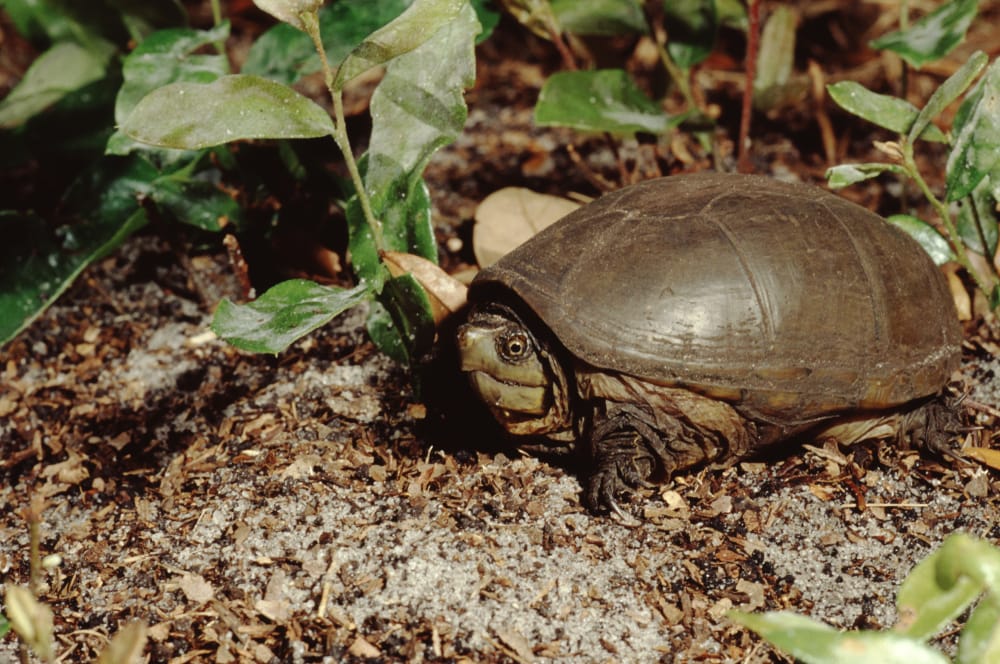
Do you know turtles are the oldest and most primitive groups of reptiles, having evolved millions of years?
Although Texas is best known for having snakes, the state’s terrain supports a vast range of turtles in different habitats. As a result, turtles are everywhere within the state, from the marshes in the east to the deserts in the west.
We will look at the various turtle species in Texas, from some of the scarce and threatened species like the Desert Box Turtle to the most common.

Share This Image On Your Site
You May Also Like: Snakes In Texas: 9 Different Types Of Venomous And Nonvenomous Snakes Slithering In Texas
1. Chicken Turtle (Deirochelys Reticularia)

Chicken turtles are semi-aquatic species that live in the eastern parts of Texas and are on the verge of becoming extinct.
These turtles spend most of their lives in slow-moving waters, preferably swamps and ponds.
They have long, striped necks and irregular oval-shaped shells. Coloring varies from olive ringed with yellow to brown, with churning patterns that replicate a net.
Chicken turtles are omnivores who mainly eat crayfish, frogs, and plants.
The turtles worry about moles and snapping turtles besides being on the lookout for fishermen looking for their chicken-like meat.
2. Ornate Box Turtle (Terrapene Ornata)

The Ornate Box Turtle is inherent to North America and a prevalent land turtle among pet lovers. Unfortunately, the breed is threatened in several states, including Texas, but they are still easy to find in pet shops.
Adult Ornate Box turtles grow up to 4-5 inches (10-12cm) and appear dark in color. These turtles have yellow stripes on their shells and bodies and weigh between 198g to 530g (7-18 ounces).
The turtles have an average lifespan of 40 years and 28 years in captivity in the wild, respectively. However, wild Ornate Box turtles taken as companions rarely survive as they cannot adjust to captive surroundings.
3. Three-Toed Box Turtle (Terrapene Carolina Triunguis)

Three-Toed Box Turtles are easy to find anywhere between Eastern Texas and the northern parts of the Florida Panhandle. The turtle species is a subspecies of the Eastern Box turtle.
They inhabit humid areas like grasslands and marshy meadows. Notably, they prefer regions with high humidity and access to slow-moving water, more so ponds and streams.
However, these turtles are hardy and can adapt to various habitats.
The three-toed turtles have three nails on their rear- legs. Furthermore, they have high arched sheaths that appear olive or brown, and their plastrons are yellow.
Three-toed turtles are omnivorous and roam on land in search of food. They feed mainly on earthworms, invertebrates, and vegetation.
4. Desert Box Turtle (Terrapene Ornata Luteola)

The Desert Box turtles are one of the subspecies of the Western Box Turtle. These subspecies appear similar to the Ornate Box Turtle highlighted above, and the only difference between the two is the amount of yellow color on their bodies.
The Ornate box turtles have fewer yellow stripes than the Desert box turtles.
These turtles are easy to find in arid and semi-arid regions and are only active during summer. The species requires soil that is easy to burrow for creating nests and hibernating.
The turtles have a dome-shaped shell that appears reddish-brown. They are omnivores and feed on insects and desert vegetation like cacti.
Desert box turtles make interesting pets that are pleasing to watch.
5. Rio Grande Cooter (Pseudemys Gorzugi)

Rio Grande Cooters are semi-aquatic freshwater turtles commonly found in the Rio Grande- the border between Mexico and Texas. It’s easy to distinguish this species from other Cooters through the black oval that runs along the flanks of their plastrons.
The shells of Rio Grader Cooters have hues varying from dark brown to olive green. The backs of the shells are also distinctly pointed. They also have whirling patterns of red, orange, and yellow streaks.
These turtles are omnivorous but prefer eating vegetation and fruits. However, they sometimes eat invertebrates and mollusks.
6. Missouri River Cooter (Pseudemys Concinna Metteri)

Another subspecies of the River Cooter is the Missouri River Cooter. These are semi-aquatic turtles that occur in streams and rivers in eastern Texas.
These freshwater turtles have a marginally domed shell that appears brown to olive at a glance. The species also have beautiful yellow markings on their shells and bodies. The Missouri River Cooter differs from other Cooter subspecies due to their arched vertical prefiguring rather than the ordinary net line coloration.
Similar to Rio Grader Cooters, Missouri River Cooter are omnivores that prefer eating vegetation rather than meat.
These turtles enjoy reclining on rocks and logs at the water’s threshold. The average adult size of a Missouri River Cooter is between 8 and 12 inches (20-30cm).
7. Texas River Cooter (Pseudemys Texana)

Texas River Cooters occur in streams and rivers in central Texas.
The shells of Texas Cooters range from dark green to olive, swathed with yellow whirling marks. These species of turtles are also distinctive through the vertical yellow stripe behind their eyes.
Texas cotters are herbivores and prefer eating vegetation. However, sometimes they feed on small fish and insects.
8. Rough-Footed Mud Turtle (Kinosternon Hirtipes)

Rough-footed Mud turtles are rare in Texas and are limited to the southwestern areas, especially around the Big Bed region. These turtles are aquatic species and thrive well in artificial habitats.
The Round Footed Mud Turtles have round shells that are olive to yellowish. Their plastrons and skins have a similar color, allowing them to blend in easily. Identical to many mad turtles, these species have fleshy barbels bulging from their chin.
These turtles are omnivorous and feed on fish, mollusks, and invertebrates alongside plants.
The turtle species spend most of their time in areas of slow-moving water where they burrow into the mud at the bottom.
9. Eastern Mud Turtle (Kinosternon Subrubrum)

The Eastern Mud Turtles, also referred to as Common Mud Turtles, are semi-aquatic turtles prevalent as pets across Texas. These turtles have a lifespan between 35 and 40 years.
Although they are small and not easy to handle, Eastern Mud Turtles still make for good pets.
A few fun facts to note are that these species are not fantastic swimmers and prefer shallow water. Also, the Eastern Mud turtles hibernate by burrowing into the sand during winter.
But how do you distinguish an Eastern Mud turtle from the rest of the mud turtles in Texas? The answer is simple.
Eastern Mud turtles have smooth elongated carapaces that range from brown to yellow. Also, their shells do not have any markings and slope slightly at the front and drop sharply at the sides and back.
Moreover, they have outsized yellowish-brown plastrons and gray skin covered with spotted markings—adult Eastern Mud turtles measure between 4-5 inches (10-12cm).
These turtles inhabit shallow and slow-moving waters and wetland habitations with dense vegetation. The vegetation provides cover from predators and acts as hunting grounds for their prey.
10. Yellow Mud Turtle (Kinosternon Flavescens Flavescens)

The Yellow Mud Turtle, also termed the yellow-neck mud turtle, is native to North America. These turtles belong to the mud turtle (Kinosternon) genus, which comprises other mud turtles like the Mississippi and Eastern Mud Turtles.
These turtles are small and have an average length of 4.48 inches (11cm). However, male adults are usually larger compared to females. Also, they are referred to as yellow mud turtles due to the yellow coloring around their head and neck. At times, the color extends to their shells.
Despite being aquatic turtles, the yellow Mud Turtles forage for food on land and water. Typically, they feed on fish, snails, shrimps, carrion, and vegetation.
11. Mississippi Map Turtle (Graptemys Pseudogeographica Kohnii)

Mississippi Map Turtles are common in eastern Texas and are a subspecies of False Map turtles. These turtles have a dark shell that often appears brown or black with contour yellow colorations.
Adult Mississippi Map Turtles have a sequence of black slanting overturns running down their shells. The turtles are aquatic and rarely travel far from water.
They enjoy basking on rocks overseeing water surfaces. Like most turtles, they are omnivorous and feed on aquatic invertebrates, small fish, and underwater vegetation.
12. Sabine Map Turtles (Graptemys Sabinensis)

Sabine Map turtles are a subspecies of the Ouachita Map turtle and are only found at River Sabine in Texas.
It’s easy to distinguish these turtles from the rest of the subspecies through the back-tipped ridges that run down the spines of their shells. Also, their scutes are shielded with contour patterns that resemble a map.
The species’ faces exhibit yellow markings, and their plastrons appear yellow to cream.
13. Common Musk Turtle (Sternotherus odoratus)

The Common Musk turtles are mainly known as “stinkpots” because of the strong odor they produce from their musk glands to deter predators. The turtles are present in the eastern regions of Texas.
The common Musk turtles have a dark brown, slightly black unmarked shell. Their head is dark and has two yellowish stripes. They also have fleshy barbels on the chin and neck. These turtles have a steep and peaked shell. The size of an average adult turtle ranges between four to five inches.
The common Musk turtles are omnivores; they feed on mollusks and small amphibians. They live in particular habitats such as marshy areas with slow-moving water.
14. Razor-backed Musk Turtle (stretherrous carnations)

The Razor-Backed Musk turtles come from the family Kinosternidae. They occur in the eastern parts of Texas. They are mainly aquatic and prefer staying in habitats with slow-moving water, like swamps.
The Razor-Backed Musk turtles have shells of different colors; some have black shells while others have brown, grey, or olive shells.
Their scutes resemble a series of razor-like humps while their shells are edged and have a black hue. The turtles have either brown or grey skin with black dots.
Adult Razor-backed Musk turtles’ sizes range from 4-6 inches (10-15cm) and have a lifespan of about 50 years.
Razor-backed Musk turtles are mainly carnivores and feed on meat, mainly from invertebrates, shellfish, and small fish.
15. Big Bend Slider (Trachemys Gaigeae)

The Big Bend Slider is also known as the Mexican Plateau Slider and comes from the family Emydidae.
They are an aquatic species found in the western parts of Texas counties. Their primary habitats are rivers and ponds, where they enjoy basking in the sun.
Big Bend sliders appear almost the same as Red-Eared Sliders, but don’t confuse the two. Instead, big Bend Sliders are differentiated by their orange oval marking behind the ears.
The turtles are mainly herbivores that feed on grass, but a few eat invertebrates on rare occasions.
16. The Red-eared Slider (Trachemys Scripta Elegans)

Apart from the Red-eared Slider, these turtles also have other names like Water Slider and Red-eared Terrapin and originate from the family Emydidae.
This turtle species is widespread in the pet trade. They are semi-aquatic and found in most parts of Texas. Red-eared Slider turtles prefer living in areas with slow-moving water like ponds and rivers.
Red-eared Sliders have olive-green shells with yellow stripes on the scales. Their heads are dark-colored and have yellow band markings and red patches behind the eyes.
They are omnivorous and feed on small fish and small invertebrates.
A typical adult has an average size of 6-8 inches (15-20cm).
17. Midland Smooth Softshell Turtle (Apalone mutica mutica)

The Midland Smooth Softshell turtles mainly occur in the eastern parts of Texas. Their primary habitats are large rivers or areas with large sandbars raised above the water.
These turtles don’t have a hard shell. Instead, they have a soft shell that looks like leathery pancakes. In addition, the species have a dark gray hue with stripes running behind their eyes and snouts.
The Midland Smooth Softshell turtles are mostly active during the day and rely on the shallow sand for sleep and breeding.
Like most turtles, they are omnivorous and feed on insects and crayfish.
18. The Spiny Softshell Turtles (Apolaone Spenfera)

The Spiny Softshell turtles have four subspecies, each occupying a different region and habitat. The four subspecies include;
The Guadalupe Spiny Softshell (Apolone Spinifera Guaddalupensis) is found in the Guadalupe and Nueces rivers in the southeastern part of Texas.
Pallid Spiny Softshell (Apalone spinifera Pallida)- inhabit the northeastern parts of Texas and have small white dotted shells at the rear.
The western Spiny softshell (Apolone Spinifera)- the subspecies is located in the northern parts of Texas, and they have distinctive dark spots on their greyish shell.
The Texas Spiny Softshell (Apolone Spinifera Emory) is found in Texas’s northern areas, especially on the Pecos and the Rio Grande rivers. These subspecies have pale rims around their shells and quickly get agitated.
19. Painted Turtles (Chrysemys Picta)

There are two types of subspecies of Painted turtles: the Southern Painted (Chrysemys Picta Dorsalis) and the Western Painted (Chrysemys Picta belli).
The two subspecies are very rare in Texas. The Southern Painted turtles are found in areas around Caddo Lake near the Louisiana border. In contrast, the other subspecies, the Western Painted Turtles, are found in the western counties of Texas.
These Painted turtles have a dark shell with yellow to red colors on the edges and yellow-striped faces.
The Painted turtles are mainly aquatic and mainly occur on lakeshores or ponds.
They are omnivores and feed on frogs and underwater invertebrates. A fun fact about the painted turtles is that they have to be submerged in water to swallow food.
20. Alligator Snapping Turtle (Macroclemys Temmincki)

These turtles are also referred to as the Loggerhead snapper and fall among the largest freshwater turtles in the world.
They have thick and ridged shells and beak-like jaws capable of crushing their prey. No wonder they prey on smaller turtles.
Alligator Snapping Turtles are aquatic and live in deep waters such as lakes. Unfortunately, the species is greatly threatened in Texas due to habitat degradation and overharvesting by humans for meat.
You can find them in the eastern areas of Texas around the Trinity River. The Alligator Snapping Turtle are carnivores and can feed on anything they catch.
21. Common Snapping Turtle (Chelydra serpentina)

The Common Snapping turtle is also known as the Common Snapper or the Eastern Snapping Turtle from the family chelydridae.
The turtles are located in the southern and western parts of Texas.
They are aggressive when disturbed, often give a hiss, and may even bite if approached. Unlike other turtles, the Common Snapping turtles do not bask. Instead, they prefer remaining submerged in water.
The turtles’ shells are usually dark brown or green. The species are differentiated by their hooked beaks, saw-like tails, and strong claws.
These turtles are mainly omnivores and feed on fish, aquatic prey, and underwater vegetation.
22. The Texas Diamond-backed Terrapin (Malaclemys Terrapin)

The Texas Diamond-backed Terrapins come from the family Emydidae and are mainly found in brackish waters and river estuaries. And often swim with their head poking out of the water.
They have gray skin with black spots. Their shells are wedge-shaped with concentric rings around the scutes. Their shells are brown and gray.
Males are bigger than females, and their average size is 4-8 inches (10-20cm) long.
The Texas Diamond-backed Terrapin turtle feeds on invertebrates and sometimes vegetation.
23. Green Sea Turtle (Chelonia Mydas)

Green Sea turtles are one of the most endangered sea species globally. Their primary habitat is on the bays and shores on the coastline.
The turtles have smooth shells that are green or brown and shaped like a heart. The species also have scaly skin with green shades.
They are herbivores and feed on algae and other sea vegetation.
The size of an adult Green Sea Turtle ranges from three to four feet.
Green Sea turtles have one of the longest lifespans of any turtle species and any animal species at 80 to 100 years.
24. Hawksbill Sea turtle (Eretmochelys Imbricata)

The Hawksbill Sea turtle is another critically endangered species from the Cheloniidae family.
Their primary habitat is in the shallow coastal areas with rocky or tropical waters. The turtles are omnivores and feed on invertebrates and sea vegetation.
The turtles have a prominent beak-shaped mouth that resembles the hawk’s beak. In addition, they have an oval-shaped shell with shades of amber and some unique markings.
Adult Hawksbill Sea turtles have an average size between 30 to 35 inches (76-22cm) long..
25. Kemp’s Ridley Sea Turtle (Lepidochelys Kempii)

The Kemp’s Ridley Sea Turtle is another endangered sea species.
The turtle’s primary habitat is on the sandy and muddy coastline. They are carnivores and mainly feed on crustaceans and shellfish.
They have a slightly hooked beak and triangle-shaped head. Their shell is gray and round-shaped.
26. Loggerhead Sea Turtle (Caretta caretta)

The Loggerhead Sea turtles are the last turtle species in our guide today. These turtles live in coastal regions with tropical waters and nest their eggs on the sandy ocean beaches.
They have a very large hardshell with a reddish-brown appearance. Their undersides are creamy and yellowish. They also have very long flippers to facilitate swift movement underwater.








